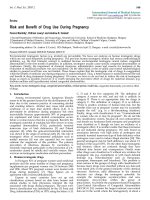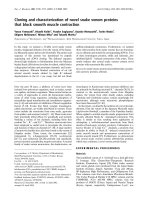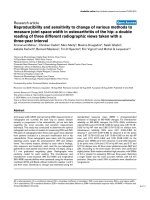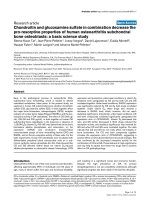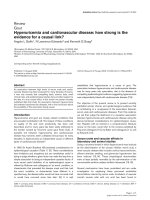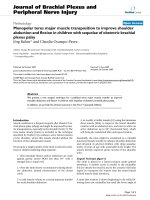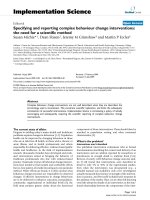Báo cáo y học: "Trunk and hip muscle recruitment patterns during the prone leg extension following a lateral ankle sprain: A prospective case study pre and post injury" ppsx
Bạn đang xem bản rút gọn của tài liệu. Xem và tải ngay bản đầy đủ của tài liệu tại đây (204.65 KB, 4 trang )
BioMed Central
Page 1 of 4
(page number not for citation purposes)
Chiropractic & Osteopathy
Open Access
Case report
Trunk and hip muscle recruitment patterns during the prone leg
extension following a lateral ankle sprain: A prospective case study
pre and post injury
Gregory J Lehman*
Address: Department of Graduate Studies, Canadian Memorial Chiropractic College, Toronto, ON, Canada
Email: Gregory J Lehman* -
* Corresponding author
Abstract
Background and case presentation: The prone leg extension (PLE) is commonly used to
identify dysfunction of muscle recruitment patterns. The prone leg extension is theorized to
identify proximal muscle disturbances which are a result of distal injury or dysfunction (i.e. an ankle
sprain). This case study compares the trunk and hip muscle (bilateral lower erector spine, ipsilateral
hamstring and ipsilateral gluteus maximus) timing during a PLE of a 27 year old female runner during
a healthy state (pre ankle sprain) and 2 and 8 weeks post ankle sprain.
Results and discussion: The gluteus maximus muscle onsets at 8 weeks post injury appeared to
occur earlier compared with 2 weeks post injury. The Right Erector Spinae at 8 weeks post injury
was also active earlier compared with the participant's non-injured state. A large degree of
variability can be noted within trials on the same day for all muscle groups.
Conclusion: An acute ankle injury did not result in a delay in gluteus maximus muscle activation.
The utility of the prone leg extension as a clinical and functional test is questionable due to the
normal variability seen during the test and our current inability to determine what is normal and
what is dysfunctional.
Background
The prone leg extension (PLE) test is used by therapists
who manually palpate the posterior muscles and observe
trunk kinematics in an attempt to identify deviations from
a supposed optimal. A dysfunctional firing pattern is
assumed to exist when postural muscles (hamstrings and
erector spinae) initiate the movement and a delay in glu-
teus maximus firing is evident [1]. As well, inconsistent or
altered firing patterns are assumed to be indicative of dys-
function. While dysfunctions in the trunk are hypothe-
sized to alter the optimal firing pattern, distal dysfunction
(ankle sprain) is also theorized to influence the proximal
order of optimal firing patterns [2]. An ankle sprain or
lower leg injury is theorized to result in "imbalances" in
the firing pattern of proximal muscles due to the dysfunc-
tion of distal segments. This distal dysfunction is assumed
to affect the proximal segments via the kinetic chain from
distal to proximal during weight bearing.
Bullock-Saxton et al [2] investigated the influence of a pre-
vious ankle sprain on the firing order and timing of the
posterior trunk and leg muscles during the PLE. The
authors found a significant difference in the onset of the
gluteus maximus activity (delayed onset) in the group
Published: 27 February 2006
Chiropractic & Osteopathy 2006, 14:4 doi:10.1186/1746-1340-14-4
Received: 30 November 2005
Accepted: 27 February 2006
This article is available from: />© 2006 Lehman; licensee BioMed Central Ltd.
This is an Open Access article distributed under the terms of the Creative Commons Attribution License ( />),
which permits unrestricted use, distribution, and reproduction in any medium, provided the original work is properly cited.
Chiropractic & Osteopathy 2006, 14:4 />Page 2 of 4
(page number not for citation purposes)
with previous ankle sprains compared with the control
group. Of note was the lack of support for the theorized
ideal pattern of muscle onset in the control group.
The Bullock-Saxton study [2] was a cross sectional study
that is inherently unable to determine if an ankle sprain is
a cause of disturbances in the muscle firing pattern during
the PLE. Presented in this case study is a longitudinal
quantitative assessment of the muscle onset timing of pos-
terior trunk and leg muscles during the prone leg exten-
sion following an acute lateral ankle sprain. This case
study will specifically address whether an acute ankle
sprain precedes a delay in the muscle activation of the
ipsilateral Gluteus Maximus muscle.
Case presentation
Overview
This case study is a product of serendipity. A 27 year old
female runner was initially part of an experimental study
documenting the muscle onset timing of the posterior leg
and trunk muscles during the prone leg extension. At the
time of the study the participant had no leg or spine inju-
ries. The participant was part of the asymptomatic control
group. Five months after the completion of the study this
participant suffered an inversion right ankle sprain during
a rainstorm while leaping into a camping tent filled with
children. At 2 and 8 weeks post ankle sprain the PLE
extension test was performed while recording the poste-
rior muscle activation EMG to determine if an ankle injury
influences the timing of muscle activation during the PLE
as compared with an injury-free PLE onset timing pattern.
Participant characteristics
Twenty seven year old female distance runner (height –
167 cm, weight -58 kg) suffered a right ankle inversion
sprain. X rays revealed no fractures. Informed consent to
participate in this study was received from the subject. In
the initial study the participant read and signed an infor-
mation and consent form that was approved by the
Research Ethics Board of CMCC. For the second half of the
study the subject was notified of the risks and benefits of
the study which complied with the World Medical Associ-
ation declaration of Helsinki on the ethical conduct of
research using human participants within a private prac-
tice and agreed to have her results published.
Treatment & subjective functional rating
No passive therapy was received by the participant. The
participant was encouraged to perform daily weight bear-
ing exercise and range of motion exercises. The participant
was running within two weeks of the injury with pain and
not at her pre injury level. At two weeks post injury the
participant reported that she felt she was functioning at
60% of her optimum. At 8 weeks post injury the partici-
pant reported that she was running 95% pain free with lit-
tle loss of function.
Experimental protocol
An identical testing protocol was used across the 3 exper-
imental days (pre injury, 2 weeks post injury and 8 weeks
post injury). The muscle activity of the right gluteus max-
imus, bilateral lower erector spinae, and right hamstring
muscle groups was recorded during right prone leg exten-
sion while lying prone on a manual therapy table. The
position of the leg was controlled in all planes (no hip
adduction/abduction or internal/external rotation) visu-
ally by the experimenter. A rig restricting movement or a
kinematic analysis system to ensure an identical move-
ment across trials was not used as this is not similar to
what occurs during practice. The control of proper form
was limited to a visual assessment as this most resembles
clinical practice.
Data collection hardware characteristics
Disposable bipolar Ag-AgCl disc surface electrodes with a
diameter of one cm were adhered bilaterally over the five
muscle groups with a centre to centre spacing of 1 cm. Raw
EMG was amplified 5000 times. The amplifier has a
CMRR of 10,000:1 (Bortec EMG, Calgary AB, Canada).
Raw EMG was band pass filtered (10 and 1000 Hz) and A/
D converted at 2000 Hz using a National Instruments data
acquisition system.
PLE tasks
The prone leg extension exercise was performed five times
during each experimental session. The task required the
subject to lie prone at complete rest with no movement
while the EMG from each muscle was collected for 5 sec-
onds. The subject then extended their straight right leg
approximately six inches off the table. The leg was held
isometrically for 3 seconds then lowered to the table.
EMG processing
The data from each PLE trial was processed in the same
manner. The aim of the processing for this study was to
determine the order and timing of muscle activation. To
determine muscle timing, it is necessary to determine
when a muscle is considered active or "on". A muscle was
considered "on" when the level of muscle activity was
greater than 10% of the peak muscle activity during the
prone leg extension. This method of determining muscle
onset was used in the previous study by Bullock-Saxton et
al [2]. The order of activation can then be determined by
classifying each muscle as "on" when its level of activity
exceeds that of its predetermined threshold. Muscle acti-
vation time (milliseconds-ms) was referenced to the time
of activation of the hamstring muscle. For example, posi-
tive values (ms) occurred when a muscle's onset occurred
before activation of the hamstring muscle group, and neg-
Chiropractic & Osteopathy 2006, 14:4 />Page 3 of 4
(page number not for citation purposes)
ative values indicated that muscle activation occurred
after the onset of the hamstring muscle. The onset of mus-
cle activity was determined for each muscle during each
repetition of the prone leg lift. Please note that the EMG
activity was not normalized to a maximum voluntary con-
traction (MVC). While MVCs are important in the collec-
tion of EMG when there is a need for determining muscle
amplitude, this was not necessary in the current study
because muscle timing rather than amplitude was meas-
ured. Normalization would not influence the muscle
onset results.
The data was processed in the following manner: The raw
EMG signal was first full wave rectified, then smoothed
using a moving average technique which averaged every
100 points of data with an overlap 98 points. The bias was
removed from the signal to allow resting activity to be at
0. The peak muscle activity was found and each data point
was divided by this peak muscle activity. In this way, mus-
cle onset could be determined by determining the time
when the myoelectric signal exceeded 10% of the maxi-
mum. The signal was visually inspected to ensure that no
artefact occurred or that the results were biologically feasi-
ble.
Results
Table 1 presents the average activation for each muscle
before injury, 2 weeks post injury and 8 weeks post injury.
There appears to be differences in the activation timing of
the gluteus maximus between 2 weeks and 8 weeks post
injury – the gluteus maximus onset time was earlier 8
weeks post injury. There was also a significant difference
in the activation times of the Right Erector Spinae between
the pre injury status and 8 weeks post injury – the RES
onset time was earlier at 8 weeks post injury. A large
degree of variability can be noted within trials on the
same day for all muscle groups.
Discussion & implications
To the knowledge of the author this is the only prospec-
tive case documenting the longitudinal influence of an
inversion ankle sprain on muscle activation patterns dur-
ing the prone leg extension test. The results from this one
participant failed to support the idea that lower limb
injury leads to a delay in gluteus maximus firing as sug-
gested by the cross sectional study of Bullock-Saxton et al
[2].
Conversely, at 8 weeks post ankle sprain there was a
decrease in the latency of the gluteus maximus muscle
(the muscle fired earlier). This earlier firing is similar to
the differences in onset timing of the gluteus medius dur-
ing lateral ankle perturbations between groups with
chronically sprained ankles and controls [6]. Beckman
and Buchanan [6] found that the reflexive latency
response of the gluteus medius in the group with hyper-
mobile ankles was significantly reduced compared with
controls.
The lack of support from this case study and previous
research questions the utility of the PLE in determining
dysfunctional muscle firing patterns. There is little sup-
port in the research literature for the use of the PLE test in
assessing muscle onset dysfunction. Further evidence
against the use of the PLE in adequately assessing muscle
function is found in the conclusions of Pierce and Lee [3]
and Lehman et al [4] who both failed to show a consistent
pattern of muscle onsets and found high within subject
and across subject variability. Lehman et al [4] found that
the gluteus maximus was the last muscle active in 13/14
asymptomatic control subjects. This finding is considered
to be an indicator of dysfunction but appears to be nor-
mal. This delay in Gluteus Maximus firing was also found
be Vogt et al [5] in a group of asymptomatic subjects.
However, Vogt et al [5] did conclude that a consistent pat-
tern of muscle activation occurred – in disagreement with
the findings of Pierce and Lee [3] and Lehman et al [4] and
in support of the traditional theory behind the use of the
prone leg extension. The weaknesses of the PLE for identi-
fying dysfunction in muscle onset may be further ampli-
fied when function is assessed with palpation rather than
through electromyography considering the inherent inac-
curacies and lack of sensitivity compared with EMG tech-
niques.
An interesting trend in changes in muscle activation was
earlier muscle activation of the erector spinae activity.
Before the injury both erector spinae were active after the
hamstring group. Eight weeks post injury the erector
spinae preceeded hamstring activation by more than 130
Table 1: Mean (SD) EMG onset and spread (ms)
RES LES RGM Spread
Healthy Ankle 137.4 (151.8) 1.6 (56.01) 306.2 (33.18) 333 (26.32)
2 weeks Post Ankle Sprain 72 (108.1) -56.2 (84.3) 462.2 (105.9) 532.6 (121.8)
8 w Post Ankle Sprain -135 (83.4) -154 (119.2) 153.2 (79.9) 331.4 (135.4)
Values are referenced to the onset of hamstring activation. (-) values indicate that muscle activity occurred before the onset of hamstring activation.
The spread is the time difference in ms between the onset of the first muscle activated and that of the last muscle activated.
Publish with BioMed Central and every
scientist can read your work free of charge
"BioMed Central will be the most significant development for
disseminating the results of biomedical research in our lifetime."
Sir Paul Nurse, Cancer Research UK
Your research papers will be:
available free of charge to the entire biomedical community
peer reviewed and published immediately upon acceptance
cited in PubMed and archived on PubMed Central
yours — you keep the copyright
Submit your manuscript here:
/>BioMedcentral
Chiropractic & Osteopathy 2006, 14:4 />Page 4 of 4
(page number not for citation purposes)
ms. This earlier activation was also seen in the contralat-
eral Erector Spinae at 2 weeks post injury (56.2 ms before
hamstring activation). Bullock-Saxton et al [2] discussed
the idea that earlier activation of the erector spinae (pos-
tural muscles) may be a compensation for a delay or
weakness in the Gluteus Maximus. In this case study the
earlier activation was not associated with a delay in the
gluteus maximus activity. The Gluteus Maximus at 8
weeks post injury fired earlier than 2 weeks post injury
and showed a trend to firing earlier than in a healthy state.
Another weakness of the PLE test is the high variability
between trials within one individual (as seen in the cur-
rent case study) and across individuals. This variability
appears normal and limits the use of EMG in producing
data which can identify individuals with dysfunction
[3,4]. Last, the differences in muscle EMG onsets across
the testing days appear significant but may not be palpa-
ble to the human hand. The activation spread across mus-
cles was between 300–500 ms. It is questionable whether
the hand or the eye can discern a difference of 200 ms
especially considering the degree of adipose tissue above
the gluteus maximus that may act as a filter to further
inhibit an accurate subjective assessment of muscle activa-
tion timing.
While this case study failed to support the proposal that
distal dysfunction may result in proximal dysfunction
manifesting as aberrant muscle onset timing of the gluteus
maximus during the PLE, the PLE as a clinical assessment
test may still have value. The only means of assessing the
PLE has been via muscle onset timing with electromyog-
raphy. As stated earlier the trunk and hip kinematics of the
participant are observed during the performance of the
movement. No research to date has measured the kine-
matics with the aim of identifying and quantifying opti-
mal and dysfunctional movement patterns (as opposed to
the motor patterns assessed with electromyography).
Quantifying these kinematics may lead to determining the
discriminant ability of this test for the identification of
dysfunction. The PLE may have more clinical utility as a
crude test of function – minor differences in muscle
onsets may have no clinical value and may not be easily
detected by observation; however, major dysfunctions in
muscle activation (i.e. no observable gluteus maximus
contraction) would be more easily detected and may be of
more clinical value. For example, during the test a
patient's buttock may remain flaccid. This is easily seen
and may be indicative of inhibition and possible dysfunc-
tion. The use of the PLE as a gross detector of dysfunction
may be more supportable than being used to questiona-
bly detect subtle differences in firing patterns that are
within 200 ms of each other.
Conclusion
An acute ankle injury did not result in a delay in gluteus
maximus muscle activation. The utility of the prone leg
extension as a clinical and functional test is questionable
due to the normal variability seen during the test and our
current inability to determine what is normal and what is
dysfunctional.
Competing interests
The author(s) declare that they have no competing inter-
ests.
Acknowledgements
Written consent was obtained from the study participant for publication of
study results.
References
1. Janda V: Evaluation of Muscular Imbalance. Rehabillitation of the Spine: A
Practitioner's Manual Volume 6. 1st edition. Baltimore, Lippincott, Wil-
liams & Wilkins; 1996:97-112.
2. Bullock-Saxton JE, Janda V, Bullock MI: The influence of ankle
sprain injury on muscle activation during hip extension. Int J
Sports Med 1994, 15(6):330-4.
3. Pierce MN, Lee WA: Muscle order during active prone hip
extension. Journal of Orthopedic and Sports Physical Therapy 1990,
12(2):2-9.
4. Lehman GJ, Lennon D, Rayfield B, Poschar M, Tressider B: Muscle
recruitment patterns during the prone leg extension test.
BMC Musculoskeletal Disorders 2004, 5:3. 10 Feb 2004
5. Vogt L, Banzer W: Dynamic testing of the motor stereotype in
prone hip extension from neutral position. Clin Biomech 1997,
12(2):122-127.
6. Beckman SM, Buchanan TS: Ankle inversion injury and hypermo-
bility: Effect on hip and ankle electromyography onset
latency. Arch Phys Med Rehabil 1995, 76:1138-1143.
